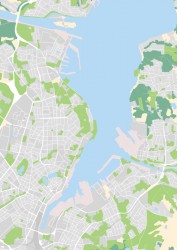In an exchange trip to Germany and the Netherlands, Mexico has strengthened the process of characterization for the implementation of actions under the Nationally Determined Contributions (NDC) in its adaptation to climate change in the water sector. During the trip, a workshop on the integrated management of coastal zones in the face of the effects of climate change at the University Christian-Albrechts of Kiel, Germany, stood out.
Representatives from various Mexican institutions traveled to the Netherlands and Germany to reflect and exchange experiences on water-related adaptation actions established in the Nationally Determined Contributions (NDC) under the framework of the Paris Agreement. During the trip, participants wrote articles to reflect on the different topics.

Mexican representatives visited the city of Kiel in Germany, one of the main maritime centers of Germany, located on the shores of the Baltic Sea. Kiel is highly vulnerable in its entire coast to the impact of weather, storm surges on the cliffs, loss of land, erosion and dislocation of sand as well as flooding due to sea level rises of both the North Sea and the Baltic Sea. In Kiel, the Mexican representatives visited the University Christian-Albrechts which was founded in 1665. It currently has 26,000 students and enjoys great prestige for being the cradle of scientists who have been awarded 12 Nobel Prizes.

The Geography Institute hosted a workshop on the integrated management of coastal zones in the face of the effects of climate change, the high vulnerability of coasts and the costs of coping with these climate impacts. The way was presented how risks have been faced and how adaptation and resilience processes are continuously being prepared for. These processes greatly affect the economy of the place, in particular the tourism sector of these recreational and leisure areas.
The management of floods is based on a model of three pillars, which provide a comprehensive protection of human and physical capital:
- Prevention through the establishment of appropriate measures and risk awareness
- Protection through the construction of flood control structures and,
- Management that combines and organizes the items above
In addition, a communal cooperation alliance on climate change adaptation has been implemented, called the “Alliance of the Climate of the Bay of Kiel”. This alliance is based on the cooperation and training of various actors such as civil protection, rescue services, corporate citizens, and has provided the public with greater knowledge on the effects of climate change, floods and heavy rains through cultural festivals.

In addition, the construction of “levees” as barriers guarantees the protection for up to 100 years, in 95 per cent of the plains and the entire shoreline. There is also a program to preserve the height of the 1.5 meters “levees”, which involves adding material that is lost by erosion. Additionally, programs have been implemented to raise the level of the land located on the only islands located in the marsh, called “highlights”, which are protected by the law with a cultural and ecological value. Another program focuses on the restoration of sand on the beaches of one million cubic meters per year. In legal matters, the region has a law for the protection of the coast and a law on the provision of construction.
The study trip took place from November 27 to December 8, 2017. It was attended by representatives of the Directorate-General for Climate Change of the Ministry of the Environment and Natural Resources (SEMARNAT), the National Water Commission (CONAGUA), the National Institute of Ecology and Climate Change (INECC), the Mexican Institute of Water Technology (IMTA), the Ministry of Urban Development and Environment of the State of Yucatan (SEDUMA) and the Technical Committee of Groundwater of the Yucatan Peninsula Basin Council.
